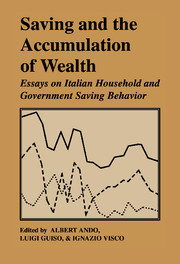Book contents
- Frontmatter
- Contents
- Foreword by Antonio Fazio
- List of contributors
- List of figures
- List of tables
- Acknowledgments
- Introduction
- I Saving trends, government deficit and demographic changes
- II Life-cycle saving and precautionary motives
- III Borrowing constraints, intergenerational transfers and bequests
- 9 Saving and borrowing constraints
- 10 Durables and non–durables consumption: evidence from Italian household data
- 11 Intergenerational transfers and capital market imperfections. Evidence from a cross–section of Italian households
- 12 Bequests and saving for retirement. What impels the accumulation of wealth?
- Appendixes
- Index
12 - Bequests and saving for retirement. What impels the accumulation of wealth?
Published online by Cambridge University Press: 05 May 2010
- Frontmatter
- Contents
- Foreword by Antonio Fazio
- List of contributors
- List of figures
- List of tables
- Acknowledgments
- Introduction
- I Saving trends, government deficit and demographic changes
- II Life-cycle saving and precautionary motives
- III Borrowing constraints, intergenerational transfers and bequests
- 9 Saving and borrowing constraints
- 10 Durables and non–durables consumption: evidence from Italian household data
- 11 Intergenerational transfers and capital market imperfections. Evidence from a cross–section of Italian households
- 12 Bequests and saving for retirement. What impels the accumulation of wealth?
- Appendixes
- Index
Summary
Introduction
This paper is an attempt to answer an age–old but important question: namely, what is the relative importance of bequests and saving for retirement in the process of wealth accumulation? To this purpose we will provide evidence on the extent of intergenerational transfers using cross–section information on the origins of the real estate holdings of Italian households.
Before the life–cycle theory of Modigliani and Brumberg (1954) came to dominate the theoretical field of saving, there was probably little doubt that leaving a bequest was the main, or perhaps the only, motivation for saving. Indeed, at the end of the last century (and for many decades thereafter) the assessment of the relative importance of the origins of accumulated wealth was not a central question for economists. They were concerned, rather, with estimating the wealth of nations.
In fact, the belief that bequest was the motive for saving enabled the French statistician Alfred de Foville to put forward in 1887 a simple but ingenious method for estimating the wealth of a nation. The idea was to use information on bequests received by the population in a given year to infer the value of the total stock of wealth.
- Type
- Chapter
- Information
- Saving and the Accumulation of WealthEssays on Italian Household and Government Saving Behavior, pp. 349 - 366Publisher: Cambridge University PressPrint publication year: 1994
- 2
- Cited by



